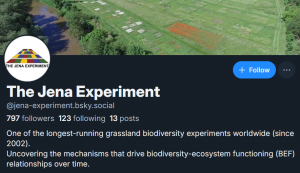New publication from Feng et al in Methods in Ecology and Evolution: Inferring competitive outcomes, ranks and intransitivity from empirical data: A comparison of different methods
The inference of pairwise competitive outcomes (PCO) and multispecies competitive ranks and intransitivity from empirical data is essential to evaluate how competition shapes plant communities. Three categories of methods, differing in theoretical background and data requirements, have been used: (a) theoretically sound coexistence theory‐based methods, (b) index‐based methods, and (c) ‘process‐from‐pattern’ methods. However, how they are related is largely unknown.

In this study, we explored the relations between the three categories by explicitly comparing three representatives of them: (a) relative fitness difference (RFD), (b) relative yield (RY), and (c) a reverse‐engineering approach (RE). Specifically, we first conducted theoretical analyses with Lotka-Volterra competition models to explore their theoretical linkages. Second, we used data from a long‐term field experiment and a short‐term greenhouse experiment with eight herbaceous perennials to validate the theoretical findings.
The theoretical analyses showed that RY or RE applied with equilibrium data indicated equivalent, or very similar, PCO respectively to RFD, but these relations became weaker or absent with data further from equilibrium. In line with this, both RY and RE converged with RFD in indicating PCO over time in the field experiment as the communities became closer to equilibrium. Moreover, the greenhouse PCO (far from equilibrium) were only similar to the field PCO of earlier rather than later years. Intransitivity was more challenging to infer because it could be reshuffled by even a small competitive shift among similar competitors. For example, the field intransitivity inferred by three methods differed greatly: no intransitivity was detected with RFD; intransitivity detected with RY and RE was poorly correlated, changed substantially over time (even after equilibrium) and failed to explain coexistence.
Our findings greatly help the comparison and generalization of studies using different methods. For future studies, if equilibrium data are available, one can infer PCO and multispecies competitive ranks with RY or RE. If not, one should apply RFD with density gradient or time‐series data. Equilibria could be evaluated with T tests or standard deviations. To reliably infer intransitivity, one needs high quality data for a given method to first accurately infer PCO, especially among similar competitors.
Citation:
Feng, Y., Soliveres, S., Allan, E., Rosenbaum, B., Wagg, C., Tabi, A. et al. (2020). Inferring competitive outcomes, ranks and intransitivity from empirical data: A comparison of different methods. Methods in Ecology and Evolution, 11(1), 117-128. https://doi.org/10.1111/2041-210X.13326



